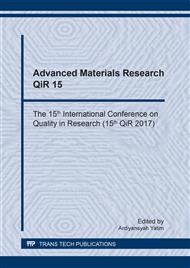p.142
p.150
p.158
p.171
p.177
p.186
p.191
p.200
p.209
The Effects of Dielectric Fluid Viscousity on Chips Formation Rate and Electrode Wear Rate in Electrical Discharge Machining of SKD 61 Steel
Abstract:
Electrical Discharge Machining (EDM) is a machine for cutting workpieces with thermal energy derived from electrical spark from tool (cathode) to workpiece (anode). As EDM process requires a dielectric fluid in the cutting operation, the characteristics of the dielectric fluid play an essential role for obtaining excellent cutting. Jatropha curcas has been demonstrated for use as a dielectric fluid in EDM process. However, the drawback is that the Rate of Metal Removal (RMR) is lower than that of generally-used dielectric fluid in industry. We consider that the cause is a much higher viscousity of the jatropha curcas. This study was conducted to investigate the characteristics of a new dielectric fluid mixture of jatropha curcas and kerosene. Kerosene was used in the mixture to reduce the viscousity of the jatropha curcas since the kerosene has a much lower viscousity. The measurement of the viscousity of the fluid mixture was performed using an Ostwald viscousimeter. Evidently, when the jatropha curcas mixed with the kerosine the viscousity of the mixture is lower than that of the pure jatropha curcas. The effects of the viscousity of the fluid mixture were investigated by measuring the RMR and Tool Wear Rate (TWR). The RMR and TWR were determined by calculating the difference in the weight of the workpiece and the tool, respectively, before and after the cutting for a certain cutting interval. The measurements were carried out for eleven different concentration of the fluid mixture by varying the current of 15 and 21 Amp, with replication of 3 times. As the result, the energy released during the cutting process affects the values of TWR and RMR. It was also found that in contrast to the effect on TWR, the RMR was not influenced by the viscousity of the mixture.
Info:
Periodical:
Pages:
177-185
Citation:
Online since:
August 2018
Authors:
Keywords:
Price:
Сopyright:
© 2018 Trans Tech Publications Ltd. All Rights Reserved
Share:
Citation:


